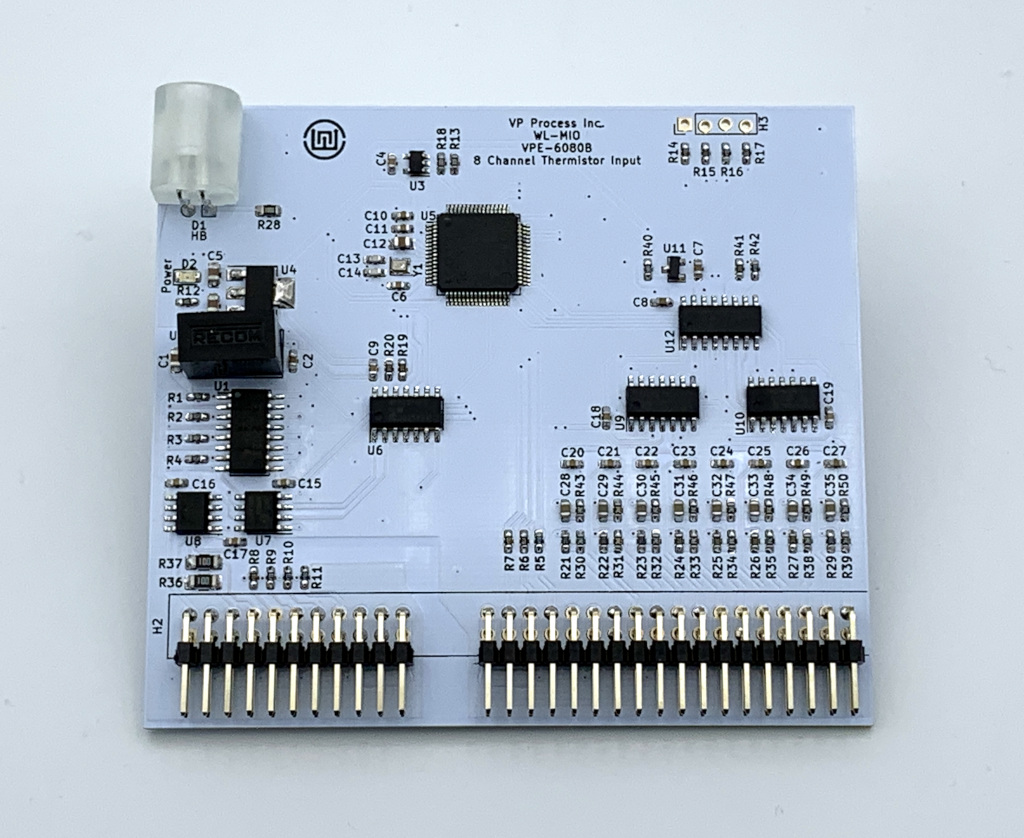Application Note: WL-MIO-AN-36080
Analog Input Thermistor Module
Part No.: VPE-6080
Analog Input 8 Channel Thermistor Module Python Demo Software

The VPE-6080 Analog Input 8 Channel Thermistor Module has 8 analog inputs that can be independantly read and configured.
The analog input module can be installed in any backplane position. The NodeID referred to in the demo program is the "Backplane ID" determined by the backplane jumpers and the addition of the slot in which the power supply is plugged into.
Example 1: If the backplane has no jumpers and the analog input module is plugged into slot position 0, the NodeID is 0 + 0 = 0.
Example 2: If the backplane has a jumper in the "8" position and the analog input module is plugged into slot position 2, the NodeID is 8 + 2 = 10.
During normal operation, the status LED flashes GREEN once per second as a "heartbeat" indicator that everything is functioning normally. If the onboard firmware detects any fault conditions, the Status LED will flash either AMBER or RED.
For the following demo code to work, the "libwlmio" library has to be installed.
Demo Python Code
The Backplane has ID = 0 and the analog input module is plugged into slot postion 7.
# vpe6080 Analog Input Thermistor Module 8 Channel
# Demo Program reads 8 channels
# Thermistor 10K Ohm 3380 Beta installed in Channel 1 to read room temperature
import asyncio
from pywlmio import *
NodeID = 7 #NodeID location is the Bacplane ID (Jumpers) and Power Supply Slot location
async def main():
init()
th = VPE6080(NodeID)
try:
await asyncio.gather(
th.ch1.configure(1), # Channel Enabled, default 3380 Beta, 25°C Room Value
th.ch2.configure(0), # Channel Disabled
th.ch3.configure(0), # Channel Disabled
th.ch4.configure(0), # Channel Disabled
th.ch5.configure(0), # Channel Disabled
th.ch6.configure(0), # Channel Disabled
th.ch7.configure(0), # Channel Disabled
th.ch8.configure(0) # Channel Disabled
)
except WlmioWrongNodeError:
print("Error NodeID = %d Wrong module installed" % NodeID) # Error Check if wrong type of module installed
except WlmioInternalError:
print("Error NodeID = %d Timed out" % NodeID) # Error Check - Typically module not installed
while True:
try:
a = await asyncio.gather(
th.ch1.read(), # Read Channel 1
th.ch2.read(), # Read Channel 2
th.ch3.read(), # Read Channel 3
th.ch4.read(), # Read Channel 4
th.ch5.read(), # Read Channel 5
th.ch6.read(), # Read Channel 6
th.ch7.read(), # Read Channel 7
th.ch8.read() # Read Channel 8
)
print("Module VPE6080 NodeID = %d" % NodeID)
print("Reading Array = ", a) # Array holds all input channel readings
# Readings scaled x10 and are in °Kelvin, add 273.15 to convert to °C
print("Channel 1 Thermistor = %0.1f Deg C" % (a[0] / 10 - 273.15)) # Print channel 1
print("")
except WlmioWrongNodeError:
print("Error NodeID = %d Wrong module installed" % NodeID) # Error Check if wrong type of module installed
except WlmioInternalError:
print("Error NodeID = %d Timed out" % NodeID) # Error Check - Typically module not installed
await asyncio.sleep(1)
asyncio.run(main(), debug=True)
Output from the demo program in a terminal window:
pi@raspberrypi:~/Desktop/wlmio/wlmio_rpi/src/demos $ python3 vpe6080_demo.py
Module VPE6080 NodeID = 7
Reading Array = [2960, 0, 0, 0, 0, 0, 0, 0]
Channel 1 Thermistor = 22.9 Deg C
Back to Top
